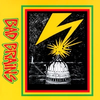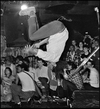





Contributor Ruben Sindo Acosta makes the case for Hardcore, a genre of music often cast aside in academic contexts, to be rightfully studied and appreciated like jazz or The Beatles.
The needle dropped on the record and I watched everyone in a packed Brooklyn Record Store deeply listen. The sounds on Pharaoh Sander’s 1969 Spiritual Jazz masterpiece Karma morph from peaceful beauty and pulse to atonal howling abandon. The whole room seemed entirely unaffected as blaring horns, atonal piano and piercing flutes wailed. While working behind the counter, I quickly flip through the bins to find another record to play. Looking to change the vibe, I put on Snapcase’s 1997 Hardcore battering ram Progression Through Unlearning. From across the room I recognize the distinct cringe on a friend’s face. Right as the screaming starts. We bickered about it’s merit until the breakdown two minutes into the opening track,“Caboose”, made part of my point for me. Any modern musician, songwriter and producer is doing themselves a great disservice by ignoring Hardcore as a reference and resource for creative uses of rhythm and unique feels. It is literally dance music with abstract song structures that focuses on intense groove and pulse.
The term “Hardcore” encompasses varying sub-genres, eras and styles. It is one of the many evolutionary branches of the 70’s Punk movement. Emerging at the same time as Post-Punk, which merged Punk with more overtly avant-garde elements, along with Non-Rock influences and New Wave, embracing a high energy yet accessible approach,Hardcore looked to be harder, faster and more aggressive than its snarling forefathers. Many now legendary hardcore bands were made up of young kids, in some cases actual teenagers who recorded their seminal works at that age. Early bands in the scene began to operate entirely independent of the mainstream music machine, releasing albums and singles on their own labels, putting on their own shows, booking tours, and laying the groundwork for a still thriving independent live music scene. The music is exactly as its name implies: intense, fernetic, explosive and at times legitimately dangerous. Matching the intensity of the music, a cornerstone to this sound is screaming. Any animal with lungs can scream and as the voice is humanity’s first musical instrument, I think screaming in music is empathy through primitivism.

Hardcore legends Minor Threat live at CBGBs
My introduction to this music was on a 4 hour car ride from Hialeah, FL to Daytona, FL with my mom, grandmother and older cousin Harold when I was 14 years old. I hadn’t spoken much to Harold before this trip. To me, he was a scary looking guy that would smile easily and, despite his intimidating demeanor, always spoke to me with honesty and respect. Having found out that I liked Green Day and Nirvana, he brought along a stack of cassettes to teach me about his favorite style of music: Hardcore. My mother drove with Harold in the front seat as co-pilot. I sat in the back seat next to my 70 year old Cuban Grandmother as he played me Cro-Mags, The Exploited, Poison Idea, Agnostic Front, Gorilla Biscuits among others. At first it sounded like fast trashy punk or simplified stompy metal. I was accustomed to the slick production of late 90’s Radio Rock bands. All I heard was anger without any relatable angst. As a short and skinny kid, I found little in common with the bulldog bark of Sheer Terror’s Paul Bearer. These sounded like the guys who wanted to beat me up, not empower me.

Cover of Bad Brains Self-titled 1982 debut
For my 15th birthday, Harold gave me a CD of Bad Brains self-titled 1982 debut album and I was totally floored. To me, Bad Brains delivered on Punk rock’s promise of total chaos. The playing was lightning fast with a distinct groove. Visceral breaks with the band playing ferociously in a honed yet human style. Originally forming as a jazz fusion band called Mind Power in 1976, Washington DC’s Bad Brains are pioneers of Hardcore. Though fellow DC band Minor Threat, as well as California bands like Black Flag, The Germs, Dead Kennedys and The Circle Jerks were essential influences on the genre, the Bad Brains early work is truly the blueprint for Hardcore. Describing the band’s approach bassist Darryl Jennifer says “if the music gets smooth, we gotta make it nice and smooth and if the music has got to get buck wild, it’s got to get buck wild”. (Source) As a young drummer, listening to Earl Hudson play these crazy fast changes and hearing the whole band change tempo and feel with no metronomic reference, like a TV changing channels, it made me feel both incredibly inspired and totally worthless.
A small example of Bad Brains’ genius is their song “Right Brigade”. It opens with a climaxing snare roll leading to a heavy stomping swing introduction in C minor at 140BPM that sounds like a pissed off Duke Ellington Big Band. Without a drum fill or any cue beyond the end of the opening bars, the band leaps up to break neck 220 BPM. The band modulates while keeping the, now dissonant, C as a central chord throughout each progression. Drummer Earl Hudson sounds like James Brown’s drummer on Live at the Apollo Vol 1, Clayton Fillyau with a ghostly smooth yet unbreakable shuffle. Bassist Darryl Jennifer is glued to the drums in a way that reminds me of the relentlessly pulsing sequencer Giorgio Moroder uses on Donna Summer’s “I Feel Love”. The verse and chorus repeats before a noisy dissolve where the drums build back to 140 BPM with an even more dissonant riff living in F sharp minor. Lead singer, HR screams “RIGHT BRIGADE '' stretching the yowling shriek to sputtering notes. His confident nonsense attitude reminds me of Dancehall Toaster, Eek a Mouse’s charismatic vocalizations. The breakdown commences as guitarist Dr. Know’s solo shreds with the abstract and spastic energy akin to John McClaughlin on Miles Davis’ “On the Corner”. After a series of triplets, and before 3 minutes have passed, the song is over. There is another recording of “Right Brigade” on their next album Rock For Light that is performed even faster and none of the nuance is lost.

Bad Brains
For many years I turned my nose up and away from pretty much every hardcore band that wasn’t Bad Brains. I hypocritically dismissed it in the way people dismiss some of my favorite music like Reggae and Jazz, “It all sounds the same”. Fast forward to 2016, and my shins are bruised. Myself and a dozen other people are doused in sweat, throwing punches, kicks, knees and elbows in every direction. “New Noise” by the Swedish hardcore band Refused is playing during a Muay Thai kickboxing class. I had listened to their groundbreaking 1998 album The Shape of Punk to Come obsessively as a teenager. Having spent the class focusing on my timing and shifting my weight, I feel the killer riffs and beats of the song in an entirely new way. For the first time in a very long time, I am dancing to this music. The timer goes off and everyone exhales, class is over. As I catch my breath and gather my things I realize I hadn’t paid any attention to heavy music in nearly a decade. While working in various record stores in Brooklyn, I would flip past anything that reminded me of my punk and hardcore past in favor of Dub, Dancehall, and Cumbia records. I’ve had my heart broken watching people dismiss each of those styles and felt it was my duty to respectfully revisit Hardcore.

HR of Bad Brains doing his patented standing backflip
There is some music that seems to say “Fuck You for listening”. A perfect example of this would be Public Image Ltd’s 1981 Post-Punk album Flowers of Romance. Each song is one aggressive drum beat, abstract soundscapes and singer John Lydon nagging, ranting and shouting. It is absolutely unforgiving, relentlessly dissonant and in my opinion really fantastic. The band feels like they’re daring you to turn off the music. After a much deeper listen I would call Hardcore “Thank You for listening” music. With so many shifts in feel and changes, it is incredibly rewarding on repeat listens. A shining example of this would be the Refused song “The Deadly Rhythm” which goes through more than a dozen unique parts that quote themselves and reinterpret the theme like the maniacal a overture moving from uptempo jazz rhythms with a walking bass line to spine shifting breakdowns and beyond.

Refused live in Sweden
My biggest takeaway was the sincerity of Hardcore’s evolution. Though drawing influences from Punk & Metal throughout it’s 40 plus year history, Hardcore filters these styles down to their core. “No frills, just the essence.” those are the words Ray Cappo of the iconic New York Hardcore band Youth of Today used to describe hardcore. They were kids who learned to play their instruments from punk rockers who actively didn’t learn to play their instruments. It is practically void of Western European Classical influence and lacks the reliance on culturally appropriated Blues of it’s Rock n Roll ancestors. The tonality of many seminal Hardcore bands is a reflection of the individual band's concept of danger and menace within the limitations of its players. It’s about where you can take it, not what you can do. The way I see it, Hardcore shines a light on the transformative beauty of animalistic expression.

Ray Cappo of Youth of Today at CBGBs

